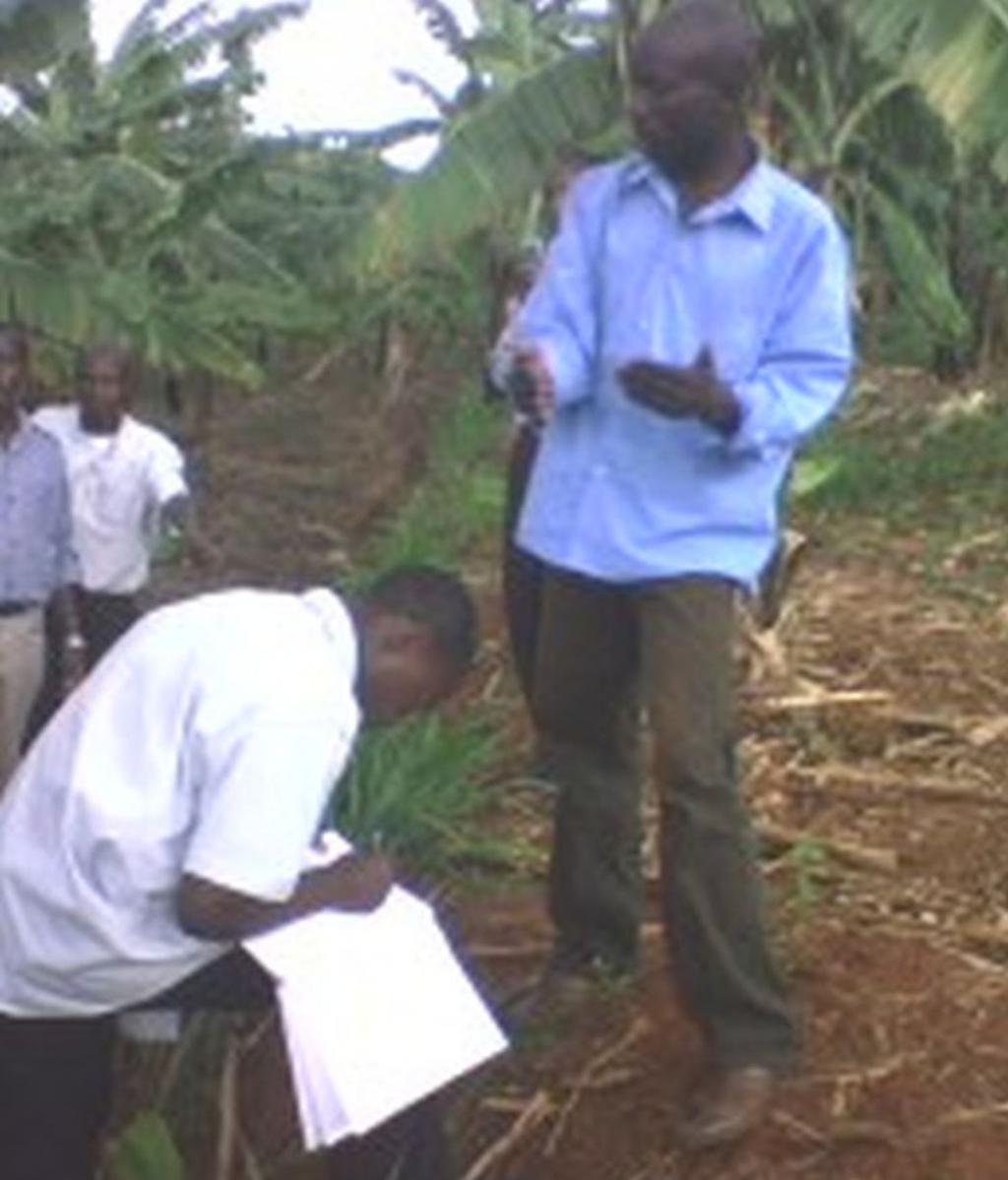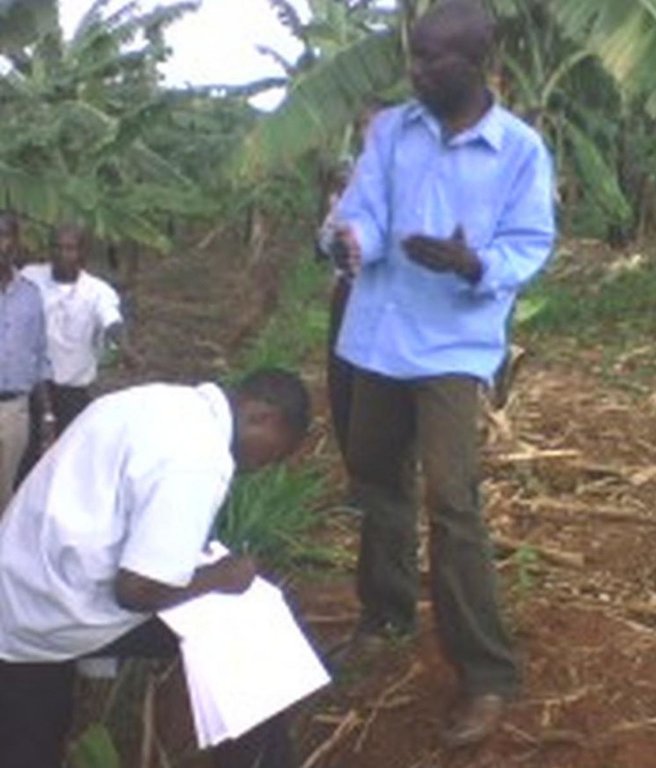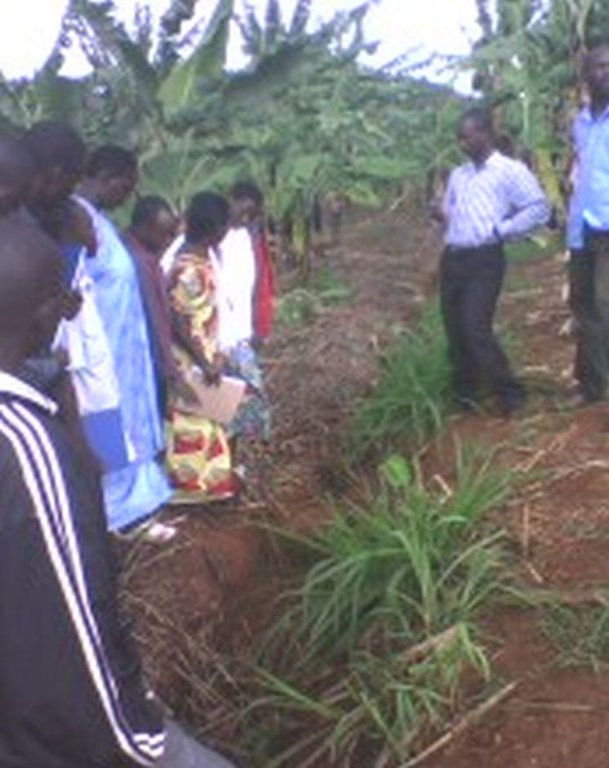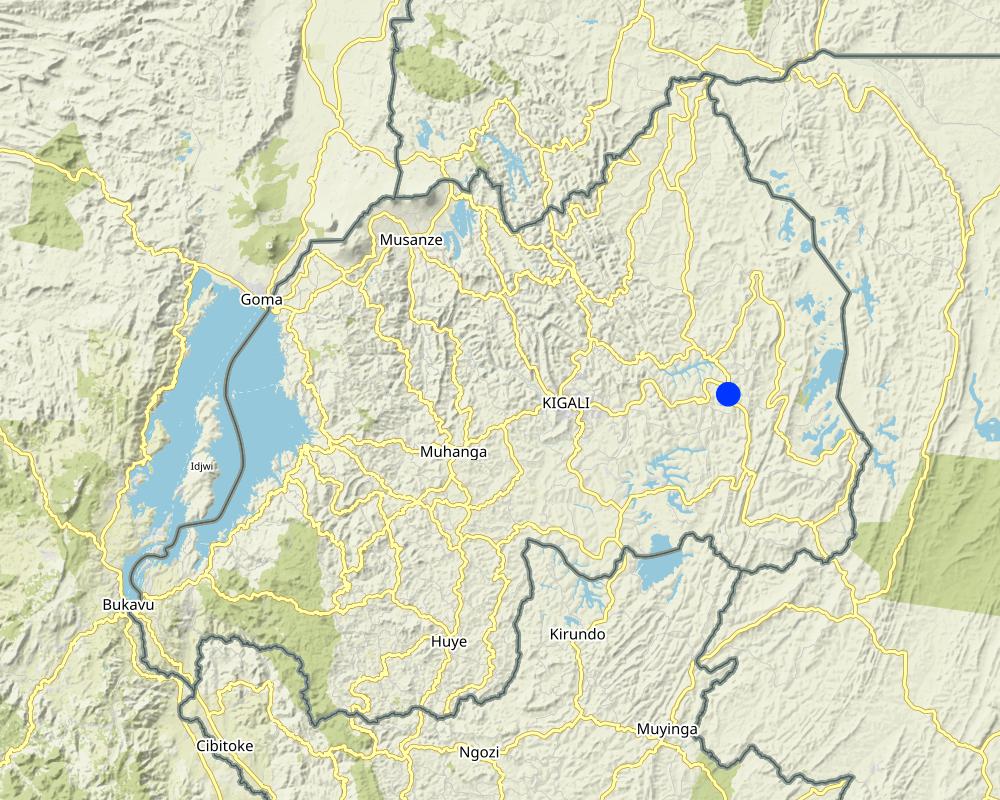Spontaneous farmer to farmer adoption [Rwanda]
- Creation:
- Update:
- Compiler: Desire Kagabo
- Editor: –
- Reviewers: David Streiff, Joana Eichenberger
Kwigira ku bandi
approaches_2585 - Rwanda
View sections
Expand all Collapse all1. General information
1.2 Contact details of resource persons and institutions involved in the assessment and documentation of the Approach
SLM specialist:
Name of project which facilitated the documentation/ evaluation of the Approach (if relevant)
The Transboundary Agro-ecosystem Management Project for the Kagera River Basin (GEF-FAO / Kagera TAMP ) {'additional_translations': {}, 'value': 96, 'label': 'Name of the institution(s) which facilitated the documentation/ evaluation of the Approach (if relevant)', 'text': 'FAO Food and Agriculture Organization (FAO Food and Agriculture Organization) - Italy', 'template': 'raw'} {'additional_translations': {}, 'value': 96, 'label': 'Name of the institution(s) which facilitated the documentation/ evaluation of the Approach (if relevant)', 'text': 'FAO Food and Agriculture Organization (FAO Food and Agriculture Organization) - Italy', 'template': 'raw'}1.3 Conditions regarding the use of data documented through WOCAT
The compiler and key resource person(s) accept the conditions regarding the use of data documented through WOCAT:
Yes
2. Description of the SLM Approach
2.1 Short description of the Approach
Diffusion of sustainable land management technologies through an effective farmer-to-farmer diffusion approach
2.2 Detailed description of the Approach
Detailed description of the Approach:
Aims / objectives: Knowledge sharing through observation and experiments of self motivated individual farmers. The spillover of a technology/practice among farmers is simply motivated by good yield and other production factors of the technologies.
Methods: Farmer to farmer learning and adoption of new products/technology
Stages of implementation: Existing of best and new technologies, curiosity of farmers about the new product, experiment of the new products and adoption.
2.3 Photos of the Approach
2.5 Country/ region/ locations where the Approach has been applied
Country:
Rwanda
Region/ State/ Province:
East
Further specification of location:
Kirehe
Comments:
The area is approximately well known
Map
×2.6 Dates of initiation and termination of the Approach
Indicate year of initiation:
1940
2.7 Type of Approach
- traditional/ indigenous
2.8 Main aims/ objectives of the Approach
The Approach focused mainly on SLM with other activities (maintenance of soil moisture and soil fertility)
Learning from others' experiences.
The SLM Approach addressed the following problems: Low productivity of lands due to poor management of soil and low/none use of agricultural inputs. In addition, the problem is aggravated by inadequate soil erosion control measures.
2.9 Conditions enabling or hindering implementation of the Technology/ Technologies applied under the Approach
availability/ access to financial resources and services
- hindering
Lack of resources especially for soil erosion technologies that require heavy investments and mobilization of all stakeholders
Treatment through the SLM Approach: Government support is required.
legal framework (land tenure, land and water use rights)
- enabling
- hindering
knowledge about SLM, access to technical support
- hindering
Soil fertility decline and soil degradation due to a lack of knowledge and resource in soil fertility management and on a better agriculture practice in banana field.
Treatment through the SLM Approach: Creation of Innovation Platforms, watershed management committees, etc.
3. Participation and roles of stakeholders involved
3.1 Stakeholders involved in the Approach and their roles
- local land users/ local communities
Innovative land users make a promotion of a technology and other farmers learn from them.
Farmers explains each other about a technology
3.2 Involvement of local land users/ local communities in the different phases of the Approach
| Involvement of local land users/ local communities | Specify who was involved and describe activities | |
|---|---|---|
| initiation/ motivation | self-mobilization | Individual farmers by simple observation of what is happening in the neighborhood. |
| planning | self-mobilization | Individual initiative and this starts by curiosity and awareness. A self motivated farmer approaches the owner of promising agricultural technologies/practices for more details. |
| implementation | self-mobilization | There is no formal model |
| monitoring/ evaluation | self-mobilization | |
| Research | passive |
3.4 Decision-making on the selection of SLM Technology/ Technologies
Specify who decided on the selection of the Technology/ Technologies to be implemented:
- land users alone (self-initiative)
Explain:
Innovative land users make a promotion of a technology and other farmers learn from them.
Decisions on the method of implementing the SLM Technology were made by by land users* alone (self-initiative / bottom-up)
4. Technical support, capacity building, and knowledge management
4.1 Capacity building/ training
Was training provided to land users/ other stakeholders?
Yes
Specify who was trained:
- land users
Form of training:
- farmer-to-farmer
- demonstration areas
Subjects covered:
soil moisture conservation and soil fertility improvement
4.2 Advisory service
Do land users have access to an advisory service?
Yes
Specify whether advisory service is provided:
- on land users' fields
Describe/ comments:
Name of method used for advisory service: Extension; Key elements: farmer to farmer exchange visit
Advisory service is very adequate to ensure the continuation of land conservation activities; the impact of the technology on production is very high.
4.3 Institution strengthening (organizational development)
Have institutions been established or strengthened through the Approach?
- no
4.4 Monitoring and evaluation
Is monitoring and evaluation part of the Approach?
Yes
Comments:
Economic / production aspects were ad hoc monitored by land users through observations; indicators: Farmers observed that the yield increases due to the technology
Area treated aspects were ad hoc monitored by government through observations
No. of land users involved aspects were ad hoc monitored by land users through measurements
There were no changes in the Approach as a result of monitoring and evaluation
There were no changes in the Technology as a result of monitoring and evaluation
4.5 Research
Was research part of the Approach?
No
5. Financing and external material support
5.1 Annual budget for the SLM component of the Approach
If precise annual budget is not known, indicate range:
- < 2,000
Comments (e.g. main sources of funding/ major donors):
Approach costs were met by the following donors: local community / land user(s) (land users): 90.0%; other (governmental SLM specialist): 10.0%
5.2 Financial/ material support provided to land users
Did land users receive financial/ material support for implementing the Technology/ Technologies?
No
5.3 Subsidies for specific inputs (including labour)
- none
If labour by land users was a substantial input, was it:
- voluntary
5.4 Credit
Was credit provided under the Approach for SLM activities?
No
6. Impact analysis and concluding statements
6.1 Impacts of the Approach
Did the Approach help land users to implement and maintain SLM Technologies?
- No
- Yes, little
- Yes, moderately
- Yes, greatly
Most of farmlands in the area and its surrounding have adopted the technology which highly reduced the soil erosion hence the increase of crop yield (probably due to the increasing of soil organic matter content).
Did the Approach lead to improved livelihoods / human well-being?
- No
- Yes, little
- Yes, moderately
- Yes, greatly
The approach helped to rapidly adopt the technology which in return improved the crop yield. Due to the efficiency of mulching in reducing soil erosion , the sustainability of land management has improved as a result.
Did the Approach help to alleviate poverty?
- No
- Yes, little
- Yes, moderately
- Yes, greatly
In the region, banana crop is a staple crop. However, due to access of new markets in cities, banana is now regarded as a cash crop hence contributing to the increase of farm income.
6.3 Sustainability of Approach activities
Can the land users sustain what has been implemented through the Approach (without external support)?
- yes
If yes, describe how:
Yes because farmers explain by their own to other farmers which facilitate the spreading of any technology quickly
6.4 Strengths/ advantages of the Approach
| Strengths/ advantages/ opportunities in the land user’s view |
|---|
| This approach can carry messages and content on other subjects than S.L.M. only (How to sustain/ enhance this strength: promote the approach as a general grassroots-based extension approach) |
| Strengths/ advantages/ opportunities in the compiler’s or other key resource person’s view |
|---|
| Both the service provider and the demand groups are local farmers; this approach therefore directly benefits only the local farming community (How to sustain/ enhance this strength: sensitization ) |
| Technologies adopted through farmer-to-farmer diffusion are likely to be more stable and sustainable because innovative farmers will only disseminate successful technologies (How to sustain/ enhance this strength: sensitization ) |
6.5 Weaknesses/ disadvantages of the Approach and ways of overcoming them
| Weaknesses/ disadvantages/ risks in the compiler’s or other key resource person’s view | How can they be overcome? |
|---|---|
| some farmers are resilient to help other | sensitization and involvement of those resilient farmers in local decision making. |
7. References and links
7.1 Methods/ sources of information
- field visits, field surveys
- interviews with land users
Links and modules
Expand all Collapse allLinks
No links
Modules
No modules





